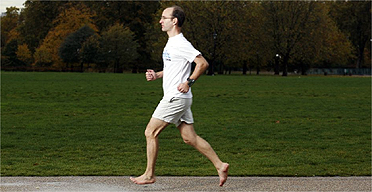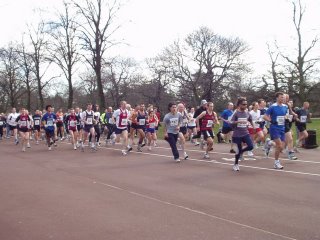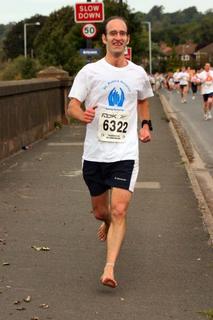Starting out running:
Last year, I casually entered the Bristol Half Marathon, thinking that it would be an easy accomplishment. That is, until I actually tried running a few months in advance. What nobody tells you is just how hard it is to get started, for a thirty something desk-bound city dweller. Well, to cut a long story short, I managed the transition from a stagger from one lamp-post-to-the-next to what I termed “steady state” running. Once I could do that, I increased the distances so that I would be confident of running the full 13.1 miles, being outside and on my feet for about two hours. Painful stuff, this running, but boy did I feel better for it in general. I really felt alive again! My poor old knees, though, didn’t enjoy it one bit. In fact, I could barely walk for two days after a long training run.
This pain meant that I could only train once per week, since I was determined to build the mileage up to get used to running the distance.
The Bristol Half Marathon itself was a lot of fun though, and I really enjoyed the crowds and the people cheering you on. What a buzz!
After a week of rest, well, a rest from running, that is, I started thinking about the wisdom of the whole running thing. I had this great new mountain bike, a present from my sister. This had none of the detrimental effects of running yet all the positive effects, and more. I could get a great workout during my commute and never had injury problems. I was back on my bike again and really enjoying the freedom that it offers and the reliability and cost as a mode of transport.
Whilst I was increasingly dissatisfied with running to the point of quitting for the sake of my joints, I stumbled across a book called “how to run fast and injury free” by Gordon Pirie. In it, he talks about the poor design of modern trainers and how silly they are with their large cushioned heels that try to protect runners from their bad running form. He jovially refers to them as “orthopaedic boots”. He advocates racing flats and other such minimalist shoes, not only for racing at the track, but for all running. He also talks a bit about how to run and the posture required, how to bend the knees. Bent knees are far better at absorbing shock than a few centimetres of foam in a shoe. He recommends learning how to run before doing things like increasing mileages and doing intervals and speed training. He also recommends running barefoot as a method for strengthening the feet. It seemed like a very strange concept when I first read it, but how could I rubbish the advice from an athlete of the calibre of Gordon Pirie, especially given that his book was edited by a doctor of medicine?
I did further research and found little about running technique in all the books on endurance running I found. They only seemed to talk about how to increase your mileage and what to eat. I did find a book called Chi running by Danny Dreyer, which is devoted exclusively to running technique and combines Tai Chi methods with running. I found it an excellent read and try to use the described techniques. It sets out a method of running that is in contrast to power running.
But, he says nothing about barefoot running. There are other methods for learning to run, such as the pose method, which involves learning a series of drills to run more efficiently. But, it seems to me, that our own bare feet are our best teacher, they provide us with the sufficient information required to teach us to run.
I found the runningbarefoot website has much information about this subject, which I recommend the interested reader refer to. There is also a Yahoo discussion list, so that you can ask questions as a beginner and get advice from more knowledgeable and experienced barefoot runners, including Ken Bob Saxton, who set up this website and who ran 13 marathons barefoot during 2004.
My investigations were moving from theory to practice. Like a good scientist, I wanted to test these ideas to see if there was any truth in them. Inspired by my initial success, I thought I’d give running one last chance, to see if running barefoot would be the answer to my injury problems, since it still seemed contrary to me that running barefoot could cure me of my knee problems. I suspended my disbelief and gave it a try and was surprised that almost immediately, my knees stopped hurting. I was no longer crippling myself with my running technique, instead, I was taking each step gently and landing not on my heels but more towards the front of my foot. I had to take it carefully at first, since my feet had been weakened by a lifetime inside shoes. If you don’t exercise a muscle it degenerates, as do bones and connective tissues.
It took some time to strengthen my feet, but in time and with careful patience, it did happen, to the extent that after a few months of practice, I could run many times per week and run weekly mileages that were impossible when I used to wear shoes. Like most people, I started out too enthusiastically and got some blisters on the soles of my feet, but once I learned to run gracefully and with better economy, these went away, not because my skin was much thicker, but mainly because my gait was much improved.
Most people (myself included until recently) think they need shoes for running. Conventional wisdom leads us to believe that there are many reasons for needing shoes for running, Such as: “We weren’t designed to run on modern surfaces such as concrete” and “What about glass?” Well, yes, I do sometimes see glass and I have even run across glass by accident without it cutting me. I have occasionally got the odd thorn in my foot, which has not really been much of a problem. I say occasionally, I mean three times in nine months of running barefoot. How many blisters would I have acquired if I wore trainers?
I think that we have sensitive feet to give us sensory feedback, so that we can run gently and carefully, which has the effect of reducing the impact on the joints. We need all the biofeedback we can get to assist us in this endeavour and if we mask this sensory input with shoes, it actually becomes harder to run naturally. It is like learning a new language wearing ear plugs.
For running on modern surfaces, I’d say that you need all the feedback from your environment you can get, so that you can run really gently, carefully and relaxed. Many natural surfaces our ancestors must have run huge distances on were not groomed grass, but the sun baked dried river beds in Africa, littered with stones and other nasty things to tread on.
Conventional wisdom can be wrong, and should at least be questioned. It is an empowering notion.













